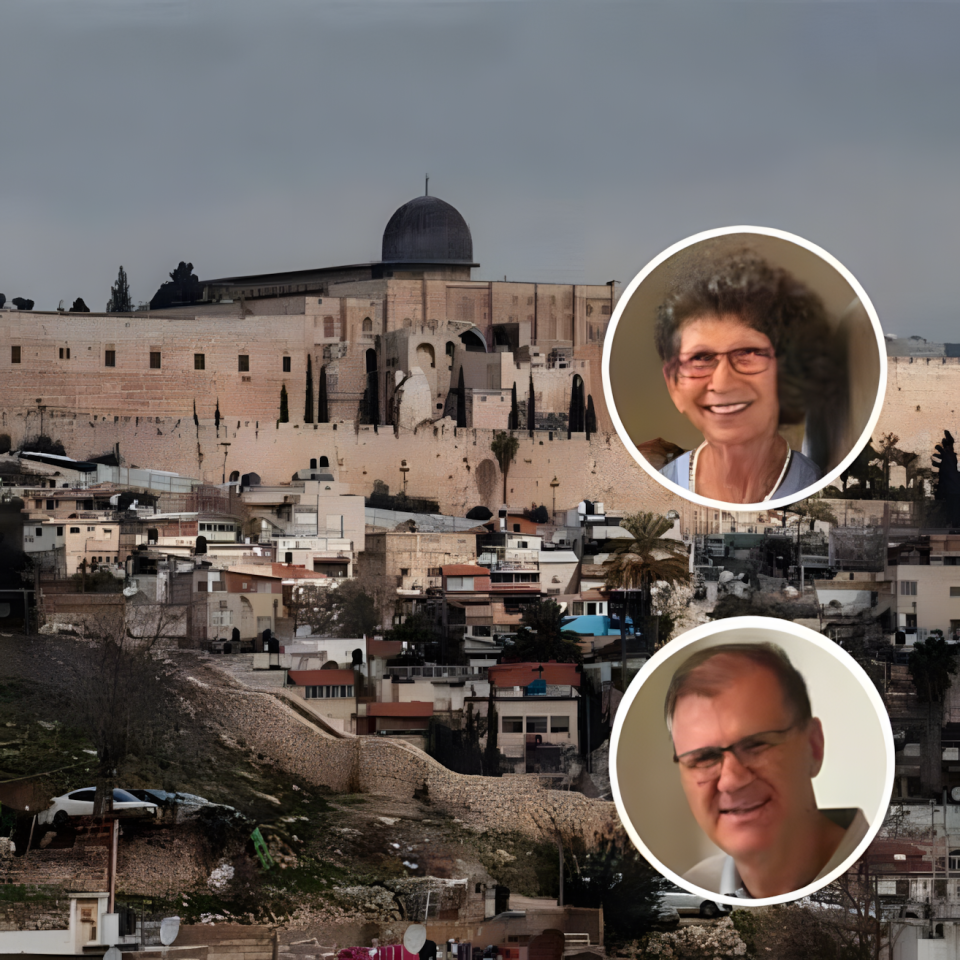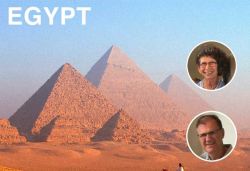We are expected at the “Pilgrim's House” of the Salesians next to the New Gate of the Old City of Jerusalem, where we will stay during “The road to Emmaus” organized by JC 2033 in spring 2023. A simple but well-maintained place with a dining room full of charm…and bedrooms as high as they are wide and long! They are delighted with this initiative and will pray for us.

"Seeds of a better world"
April 19. We visited Gabi Abu Rakaba, at his father Abraham's bazaar, opposite the Anglican S. Georges Cathedral. He gave us news of the youth movement of the Old City Churches “Seeds of better life”. He recently obtained a guide license in Israel. He is interested in “the road to Emmaus” proposed by JC2033 which is a new approach for him and he will gladly accompany us. He is also happy to make the link with the young people of the various “historic” Churches of Jerusalem. Gabi is part of the Orthodox scouts and plays the bagpipes during processions during the holidays, such as the one organized on the occasion of Easter.
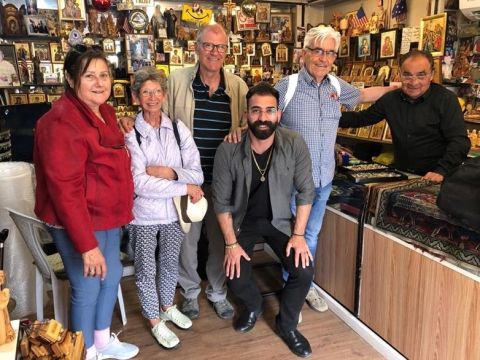 From left to right : Nicole Fatzer, Chantal et Martin Hoegger, Gabi Abu Rakaba, Daniel Fatzer and Abraham Abu Rakaba
From left to right : Nicole Fatzer, Chantal et Martin Hoegger, Gabi Abu Rakaba, Daniel Fatzer and Abraham Abu Rakaba
"Meeting is first of all listening”
Finally in the afternoon we arrived at the Franciscan Hermitage of Gethsemani (The “Romitaggio”) where we took part in a spiritual retreat until Thursday. Teresa and Fra Diego welcomed us and explained the meaning of this place where the Lord loved to come to rest with his apostles. “A place of silence, solitude and prayer where it is easier for you to hear the voice of the Lord and to find yourself intimately with him”, as the word of welcome to the pilgrim says.
The following day, April 20, a day of retreat in this inspiring place. In the evening Fra Diego meditated on the Gospel of Emmaus, the reading of that day of the mass. He pointed out that after his resurrection Jesus again gave himself to the disciples, as he had done before. What did he give: listening above all; since he began his interview with a question “what were you discussing on the way”? Then he gave the Word and the Bread, where they recognized him.
After the mass Fra Diego insisted on the fact that listening is that of the heart: “give me a heart that listens”! This prayer of Solomon is perhaps the most beautiful in the whole Bible! Listening from the heart is one of the greatest gifts we can give.
We invited him to walk the road to Emmaus next year. A Pilgrimage that will begin at this blessed place.
April 21st. Visit with André Moubarak, co-director, with his brother Tony, of the Twin Tours Agency. Due to the pandemic, tourist activities have been almost nil, but he has developed lessons on the internet and written several books. André, one of our “ambassador” in Jerusalem, is a valuable resource person, with a great creativity, good advice and a large network of relations, both on the Arab side and on the Jewish side. We are working with him to prepare the Walk to Emmaus in 2023.
We then shared a meal with John Ott, another JC2033's ambassadors. His wife, Tikvah, should also have been present but was prevented by an unforeseen event. Tikvah is the youngest of 12 children from an Orthodox Jewish family in Jerusalem. She came to faith in Yeshua following a “Visit” of the son of David who “will reign forever over the House of Jacob” (Luke 1,33)! Her family then cut ties with her for 5 years and her brother even kidnapped her to be kept in a sister’s house for 3 months, seeking to protect her. But these 3 months turned into the best quiet time for Tikvah, so strong was the love and revelation of “Yeshua the Messiah of Israel” given to her.
John told us that the Jewish people today are much more open to the gospel than they were ten years ago. But he is deeply disturbed by the lack of love which quenches unity within some messianic communities. “In Jerusalem, 2033 seems a long way off: but we need to get started, by revisiting a foundation of trust and mutual honour in developing Kingdom relationships”, he told us. https://www.johnandtikvah.com
In the afternoon we arrived at Yad Hashmonah where we spent two nights. In the evening we were treated with a festive meal on the occasion of the end of the Jewish Passover.
The challenge of Unity during the time of Coronavirus
April 22. This morning, Tsuriel Bar David, director of the “Country Hotel” of Yad Hashmona, gave us a long interview where several subjects were discussed. First on what the pandemic has meant in terms of changes for a hotelier. Domestic tourism grew, which led him to “kosherize” the restaurant to accommodate observant Jews, as tourists could no longer enter Israel. He is a caterer specializing in organic products that now provides catering.
Yad Hashmona - “the memory of the 8” was built by Finns, in memory of 8 Finnish Jews delivered to the Nazis during the 2nd World War. Besides, Tsuriel's wife is Finnish and gave him a 7th child during the Coronavirus period!
Tsuriel is also the pastor of a messianic community that meets here; he shared with us the challenge of keeping the unity of the community during the Coronavirus, as the reactions to government measures were diverse. But he and his council believe they have succeeded.
Through him we became aware of how diverse the messianic movement is in Israel. To discover the diversity of the growing messsianic Judaism - there are three times as many messianics today as 20 years ago - one can read with profit the book recently published by the Caspari Center in Jerusalem: “Jesus-Believing Israelis : Exploring Messianic Fellowships”.
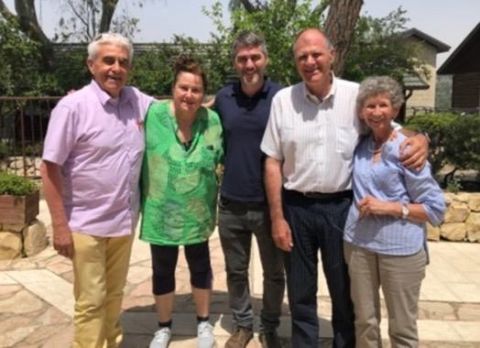 With Tsuriel Bar David
With Tsuriel Bar David
“Based on the collected data, the number of Israeli Messianic believers in 2020 stood at 15,323 people. Less than half the congregations use Hebrew as their primary language. Russian-speaking fellowships comprise the biggest group, with their 136 congregations. Hebrew-speaking fellowships came in second, at 83 congregations. Other languages included Amharic (30 fellowships), English (16), Spanish (6) and Romanian (2). The congregation’s senior leader is a native-born Israeli in only 17% of the cases. The Israeli Messianic movement can legitimately be called an immigrant movement.,” explain the two authors of this book.
And then a great debate has taken place recently (and continues!) on the question of a ministry of unity between the various communities which are Congregationalists.
Tsuriel is happy that Yad Hashmona is on the road to Emmaus – he sees it as a nod of Providence – and will gladly welcome the group of pilgrims at Easter 2023, as he did two years ago. There will be a visit to the “Biblical Garden” and a “Biblical Meal”.
Another Relationship with the Land
In the afternoon we crossed the village and went to the center of “Revive Israel” where Youval Yanaï, its director, joined us. Immediately he shared with us the turning point caused by the time of the Coronavirus.
“In November 2019, I received during worship a call to open the windows. But it was winter. When the Covid came, I understood…”. God was preparing them for a change. With Valérie, his Genevan wife and another family, they then began a community of life which then expanded. They started working the land and farming. Youval trained in agriculture and incorporated it into the 40-day training that Revive Israel offers to young messianic Israelis. “Spiritual renewal requires a different relationship with the land: working it allows us to internalize biblical teaching. The goats evangelize us! Revive Israel is what it is today: living the Gospel every day.”
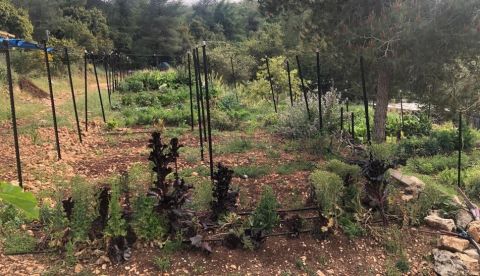
On the wall, Youval hung up a photo of his great-grandfather, who came to Palestine from Kazakhstan at the end of the 19th century. Spade in hand, he worked the earth; in the background we recognize Mount Tabor. Israelis love to connect with creation and are drawn to permaculture. This project is called “The Farm of the Third Day”. What happened on day 3? Reread the biblical stories, from that of creation to that of the resurrection, including those of Sinai and Jonah!
“God prepared us. Some would like to continue as before. But for us, everything has changed...and it's better than before,” he said. Youval again accepted to be our guide on the road to Emmaus between Yad Hashmona and Emmaus-Nicopolis, next year. He promised to invite some young people there to walk with our group.
After this beautiful encounter we decided to go exploring on the path that joins the road to Emmaus, from Yad Hashmona, following Tsuriel's advice, but after less than a kilometre we had to turn back, discouraged by brambles and rocks blocking it. We made a U-turn and headed towards Neve Illan where we found a more suitable path for the route we will take next year from the Saxum center, in Abu Gosh.
The following day, April 23, we took part in the worship – entirely in Hebrew – of the messianic community of Yad Hashmona. It began with five songs in Hebrew, including three psalms: how good it is to sing the Word of God in the language in which it was written!
After these songs, about twenty children were blessed and joined their “Sunday School”. But the older ones, another twenty were in front of us, including some children of our friend Tsuriel. Two of them are also musicians in the music group.
An elder of the community then gave an “expository preach” (a sermon that exposes the biblical text by updating it...given in English and Hebrew) on the relationships to be lived by a couple, in the family with the children and between employees and bosses, in the light of the text of Ephesians 6. I retain this sentence: “God gives us his wisdom and his Spirit so that we live healthily in our relationships with each other”.

“Mystery of Israel”
After the service, we departed for the Benedictine monastery of Abu Gosh, where we met a sister with a large bouquet. Sister Maryvonne also greeted us with a broad smile and told us that the "rose sister" is in fact the superior of the monastery of the nuns...even though she had introduced herself as the florist! In the evening we took part in the vespers prayers then, after the meal, the compline. The prayer sung alternately by monks and nuns is done in French, Latin...and in "tongues" at the time of intercession for the world. The Spirit comes to the aid of our weakness!
In the monastery garden, a section is dedicated to the memory of Aron Jean-Marie Lustiger, Cardinal Archbishop of Paris, “born a Jew, I received the name of my paternal grandfather Aron. Having become a Christian by faith and baptism, I remained a Jew as the apostles remained Jews”.
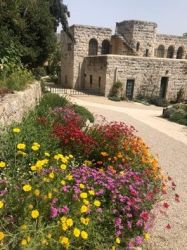
24 avril « Synagoga »
That Sunday, our Orthodox brothers and sisters celebrated Easter. In Abu Gosh and in the Catholic Church, it was "Mercy Sunday", with the story of the conversion of Thomas who asked to "see to believe". Isn't that everyone's desire, wonders a monk commenting on this text? Seeing is believing remains a privilege of the first generation of disciples. Today the vocation of the Church is to give reasons to believe.
At the time of the Lord's Supper, Communion was given by cup. I hadn't experienced it for more than two years! After mass I looked at some frescoes. The faces of Jesus, Mary and the angels had been erased by the Muslim occupiers.
One scene struck me, that of an angel pushing away a woman who held a broken spear and whose face was filled with fear and dismay. With the inscription “Synagoga”, it represented Judaism driven out by Christianity.
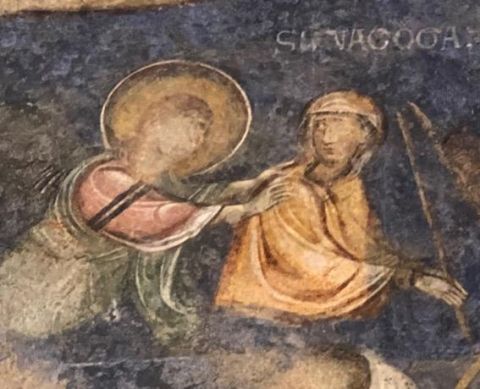
“As I contemplated the Synagoga, my thoughts took me through time. Photos of 20th century Jews with that same look of fear and dismay alongside those who hated them and hunted them without hesitation,” wrote Jewish painter Peter Maltz of this mural.
But in light of the relationships that P. Maltz had with the monks and nuns of Abu Ghosh, he drew this sketch expressing what he really felt. Now the angel embraces the synagogue!
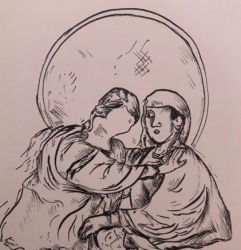
"My experience of the Christian religion has been marked by healing and compassion and not by a desire for rejection or evangelization", said the painter following his companionship with the monks and nuns of Abu Gosh who had always shown their love to him. “The rapprochement was genuine and the “repair of the world” (tikoun olam) was at work every day”.
A Path of Inner Renewal
April 25. In the morning we had an interview with Sisters Ignace and Maryvonne. They told us that last Friday, the brothers and sisters of Abu Gosh went to the shores of Lake Tiberias, as they do every year, in memory of the angel's announcement to the women at the tomb: "He goes before you into Galileo”. Sister Ignace, founder of the female monastery, immediately grasped the spirit of the JC2033 initiative: “it is a path of inner renewal; by visiting one another, we encounter the Risen One...he precedes us and sends us”. As we left this blessed place, Sister Maryvonne assured us of the prayers of the community.

We already knew Brother Olivier from the first pilgrimage on the road to Emmaus. It is he who welcomes the groups who visit this monastery and he reminded us of the vocation of this place: "To be a cordial presence, at the source of our faith, listening to the mystery of Israel”. During the Coronavirus period, the monastery closed its doors for a while, but then, when tourists could not enter Israel, countless Israelis visited it, with a spiritual openness that amazed Brother Olivier. An appointment is made with him for Easter 2023!
Our friends Nicole and Daniel Fatzer continued their stay in Jerusalem to meet actors of “Towards a Second Council of Jerusalem”, while we headed towards the Community of Latrun. Beni and his wife Sonja Kipf, newcomers from Basel, welcomed us to the restored buildings of this Crusader fort, over 900 years old. I don't think I've ever slept in such an old house!
At the end of the afternoon we descended towards the Trappist Abbey of Latrun and met Father Louis whom I had visited during my first descent on the road to Emmaus. He remembered very well these three Swiss pastors whom he had lodged for a night three years ago. It was Daniel Guillaume-Gentil, Daniel Fatzer and myself who had spoken to him about the celebrations of the 2000 years of the resurrection of Christ in 2033, “a wonderful idea that I have not stopped thinking about ever since ”.
Start Every Day with a Gift
April 26. When I woke up, Chantal wished me “Happy Birthday”. I had completely forgotten about it! “Alles gute zum Geburtstag”: at noon, I am surprised to be celebrated with an impressive “Vesuvius' planted on a cake. The language of Latrun is German - since it brings together Protestants from the Jesubruderschaft of Gnadenthal in Germany. The community was called more than 50 years ago by the Lutheran Church in Jerusalem to begin community life in the Holy Land. https://www.kloster-gnadenthal.de/jesus-bruderschaft/latrun
In the afternoon we walked with Marie-Madeleine, a young Frenchwoman on vacation with her grandmother who was a volunteer at Latrun, towards Nicopolis identified with the biblical Emmaus from the earliest antiquity.
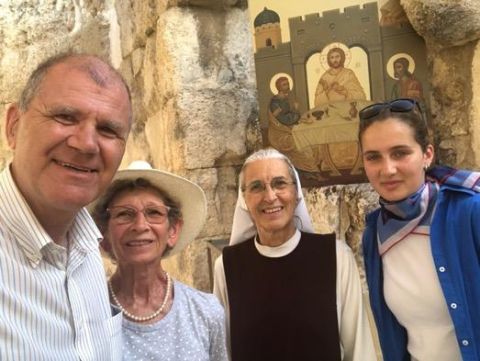
The Catholic community of the Beatitudes lives there and welcomes pilgrims. Sister Rebecca, her manager, welcomed us and we spent a good hour sharing news with each other . For this community, the end of the pilgrimages meant a break that allowed them to refocus on the Essential. We then visited the site. Our French friend who just arrived the day before...imbibes everything she sees and hears. Isn't it wonderful to begin a pilgrimage from the place where the Risen One appeared to his disciples?
The three communities of Latrun – the two Catholics as well as the Protestant – keep vivid memories of Emmaus. Thus the supper is celebrated there every day – also in the Protestant community! When I wonder why the Lord's Supper is celebrated every morning, Brother Stephan tells me that it is nice to start the day with a gift rather than doing something. He commented on the second letter of John which calls us to live in communion with God in a permanent way... and if we consider ourselves, it is enough to ask for his forgiveness and to immediately put ourselves back in communion with him through the risen Jesus, our defender with the Father (1 John 2,1). Emmaus is the feast of continuous communion!
This morning, the Eucharistic liturgy was celebrated by Brother Friedrich who began it in Hebrew with the Jewish blessing on bread and wine. The sanctus is also sung in Hebrew – Kadosh, Kadosh, Kadosh – like other songs as well as the final blessing. The community of Latrun has become a place of retreat and meeting very appreciated by the messianics.
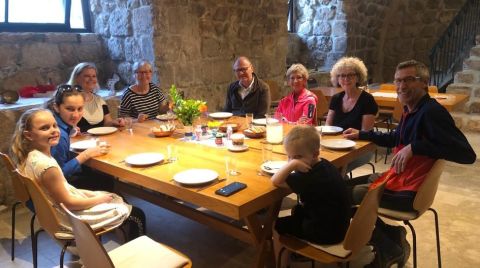
Shortly before our departure, Brother Stephan told me of the beautiful communion that is experienced between the three communities at the end of this road to Emmaus. He quoted this military saying: “Who took Latrun took Jerusalem”, because Latrun controlled the entrance to Jerusalem. He adds: “Prophetically, this could also be true in the spiritual domain: the communion lived between our three communities prefigures that of the Churches of Jerusalem”!
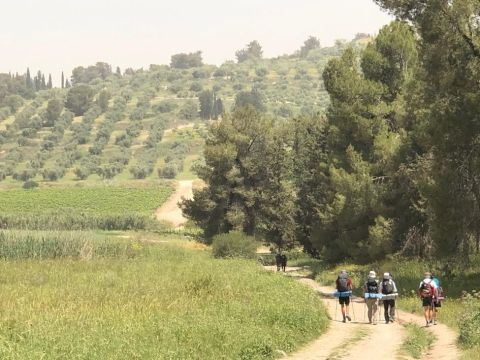 Between Latroun and Neve Shalom/Wahat al Salam
Between Latroun and Neve Shalom/Wahat al Salam
I conclude with this song from the community of Latrun that, God willing, we will visit again next year, with hopefully 33 pilgrims! "When your paschal joy shines on us who go forward with heavy hearts and blind eyes, then you walk on our path and our hearts are on fire, when Scripture is fulfilled in your resurrection".
Martin Hoegger

